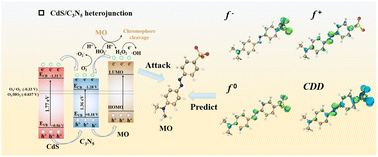Interfacial engineering boosting the photocatalytic performance of a CdS/C3N5 heterojunction for organic pollutant degradation: mechanism, degradation pathway, and DFT calculation†
Abstract
Heterojunction modulation can maintain the excellent properties of base materials while also modulating the charge behavior of the interface to improve the redox capacity. Herein, a promising heterogeneous photocatalyst based on a carbon nitride framework with 3 : 5 C : N stoichiometry (g-C3N5) and cadmium sulfide (CdS) was synthesized via a simple hydrothermal method. The formed CdS/C3N5 heterojunction promoted efficient separation of photoexcited electron–hole pairs and allowed charge storage at the interface, resulting in a high redox capacity. As expected, the apparent rate constant value of methyl orange (MO) increased to 0.078 min−1, which is almost 13 and 7 times that of g-C3N5 and CdS, respectively. The MO degradation pathways were further revealed by density functional theory (DFT) calculation and liquid chromatography-mass spectrometry (LC-MS) methods. Most importantly, the band gap structure, active species and their respective contributions are analyzed in depth to improve the photocatalytic performance of the catalyst. This work provides a new perspective for the construction of heterojunctions and environmental remediation.



 Please wait while we load your content...
Please wait while we load your content...